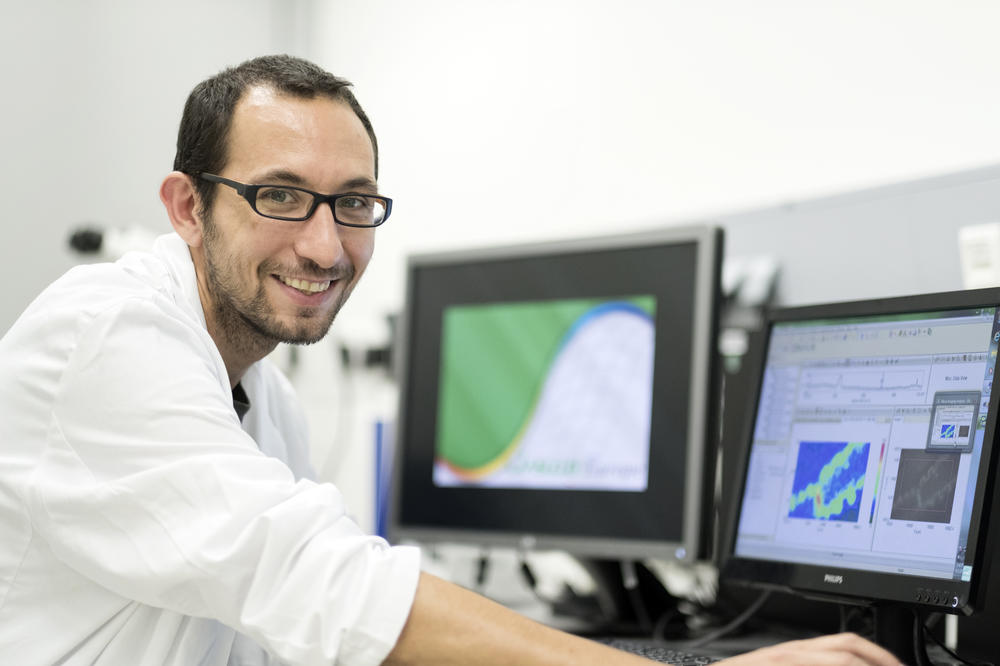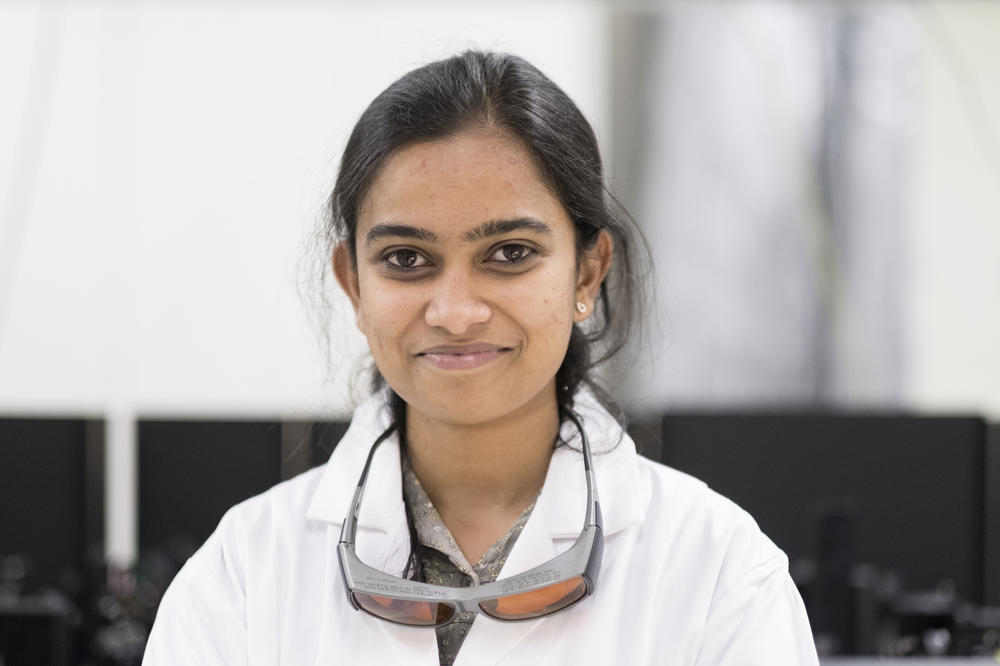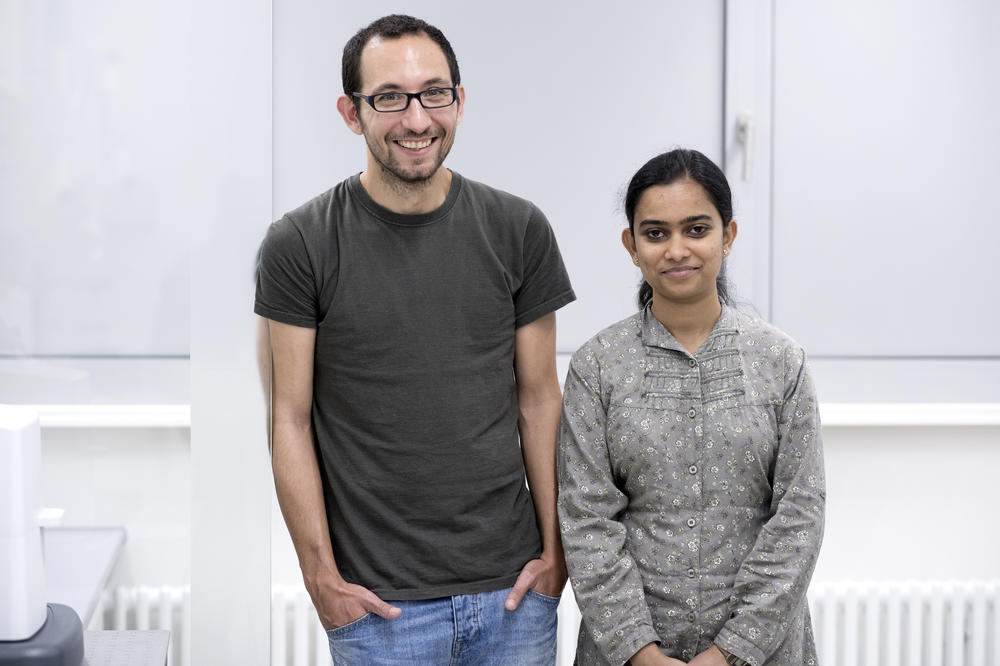Research between Disciplines
Established five years ago, the School of Analytical Sciences Adlershof offers the very best facilities for doctoral candidates in the fields where chemistry, physics, and the biosciences converge.
Jan 03, 2018
Victor Rodriguez is a doctoral candidate at the School of Analytical Sciences Adlershof. He is working on the formation of plant cell phytoliths (plant stones) composed of silicon dioxide.
Image Credit: Matthias Heyde
At the heart of the graduate school is the Photonics Application Lab at Adlershof campus of Humboldt-Universität zu Berlin. Equipped with state-of-the-art measuring devices, it allows scientists practicing a broad range of optical procedures to examine the composition of chemical solutions, crystals, and tissue samples right down to the molecular level. Freeda Yesudas and Victor Rodriguez have been working here since October 2016.
They are both doctoral candidates at the School of Analytical Sciences Adlershof (SALSA) of Humboldt-Universität. Founded in 2012 with funding under the German Excellence Initiative, the graduate school is a joint endeavor of Humboldt Universität zu Berlin, Technische Universität Berlin, and the University of Potsdam, as well as many nonuniversity research institutions such as the Bundesanstalt für Materialforschung und -prüfung (BAM) and the Helmholtz Zentrum Berlin für Materialien und Energie (HZB). International partners in the school include ETH Zurich in Switzerland, the Universidad de Oviedo in Spain, and the Hebrew University of Jerusalem in Israel.
According to Yesudas and Rodriguez, the ultramodern equipment at Adlershof was not the sole reason they applied to join the graduate school in Berlin. Yesudas was impressed by the multiple projects at SALSA, which have their roots in different disciplines. In applying, she expressed her expectation of learning about new approaches and methods that would be of use in her continuing professional development as a scientist.
The interdependencies of cell membrane molecules under changing conditions fascinate Freeda Yesudas, a doctoral candidate at the School of Analytical Sciences Adlershof.
Image Credit: Matthias Heyde
Her master’s degree in photonics made her an ideal candidate for research work on the sum-frequency spectrometer, a brand new optical installation that measures the superposition of two laser beams, one constant and the other pulsed. The extraordinary feature of this apparatus, which was developed by the head of the Photonics Application Lab, physicist Zsuzsanna Heiner, is the extremely short-pulse laser that allows examination of the surface of fluid or solid samples in very high definition, both spatially and temporally. “You could describe the sum-frequency spectrometer as a kind of video camera that takes very, very fast-frame exposures of the movement of molecules,” explains Yesudas. Unlike data from a normal camera, spectrometer data do not appear in pictures but in the form of a very long series of numbers.
“Right now, Germany is the best destination for young scientists – it has a particularly good reputation for chemistry.” Doctoral candidate Victor Rodriguez
Within her doctoral work Yesudas aims to investigate the interactions of cell membrane molecules under changing conditions such as pH value or salt concentrations. Experiments will build on this and examine the interdependencies of active substances or nanoparticles. In preparation the physicist has made extensive studies of chemical solutions and the biology of cell membranes. Heiner and her doctoral student are keen to use their findings to further develop the sum-frequency spectrometer and optimize it for the examination of biological systems.
“Right now, Germany is the best destination for young scientists – it has a particularly good reputation for chemistry,” says doctoral candidate Rodriguez. The Spaniard’s research project takes place at the intersection of chemistry, biology, and the agricultural sciences. He would like to establish the reason why, and manner in which phytoliths – or “plant stones” made of silicon dioxide – arise in plant cells. During a three-month stay at the Department of Agriculture at the Hebrew University in Israel, Rodriguez learned about the cultivation and care of plants. As a chemist, he is now also well acquainted with plant metabolism and transverse sections of leaves under the microscope.
He says that for 160 years science has been grappling with the puzzle of crystal-like structures that are stored in plant cells. There is consensus that phytoliths perform many functions in the plant, helping it cope under stress – for instance in the case of drought. On many occasions there have been periods of intensive research on the topic, mostly prompted by developments in methods and new discoveries. But fundamental questions remain unanswered: How do these minerals arrive in the cells, and what changes do they effect? Rodriguez mentions that the subject is highly topical, in that agricultural crops are increasingly at the mercy of extreme weather conditions like severe heat and drought due to climate change. By virtue of microscopy that allows examination even at the atomic level, he believes that we have never before been so close to understanding the phenomenon of phytoliths.
The School of Analytical Sciences Adlershof drew doctoral candidates Yesudas and Rodriguez with its combination of state-of-the-art equipment, interdisciplinarity, and diversity of ongoing projects.
Image Credit: Matthias Heyde
Yesudas and Rodriguez are among around 60 young scientists currently preparing doctorates under the auspices of SALSA. Coming from 28 countries including Hungary, Venezuela, Turkey, and Iran, they engage in the adventure of conducting research between disciplines and sharing knowledge with each other. “Analytical sciences are by their nature interdisciplinary,” says Janina Kneipp, who together with Ulrich Panne of BAM heads the graduate school. The interesting thing about doctoral projects at SALSA, she says, is the potential for considering the questions of one discipline from the perspective, and using the methods of, another discipline. For this reason, each doctoral candidate has two or three mentors from various subject areas and even from different institutions.
For Yesudas and Rodriguez, the great appeal of SALSA is the climate of cooperation. As part of their doctoral studies they will get to try out many research approaches and techniques and become familiar with other disciplines. Yesudas is currently working on programming with a view to the automated measuring, collection, and comparison of data, as well as the establishment of several comparable series of measurements. She has been in contact with a scientist in Potsdam to this end. For Rodriguez, ray diffraction and nuclear magnetic resonance spectroscopy are further methods he would like to deploy on his samples. There is one thing he is particularly looking forward to: in a few months he will have an opportunity to examine the nanometer depths of his “plant stones” using special equipment, the BESSY II at Helmholtz Zentrum Berlin für Materialien und Energie. “I will be one of the few scientists in the world who has been allowed to work with an electron storage ring.”



